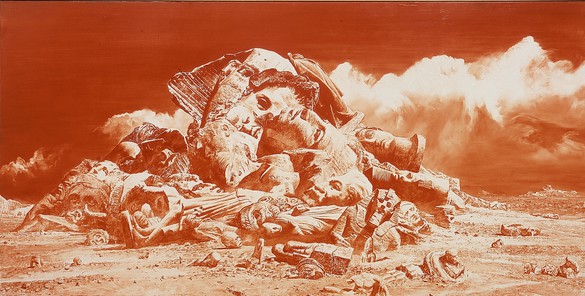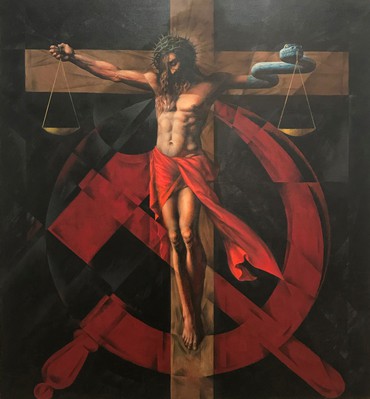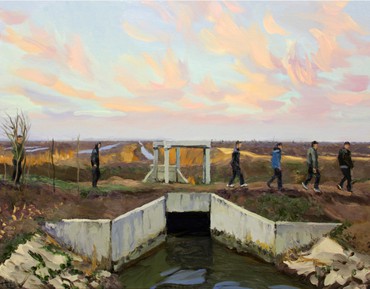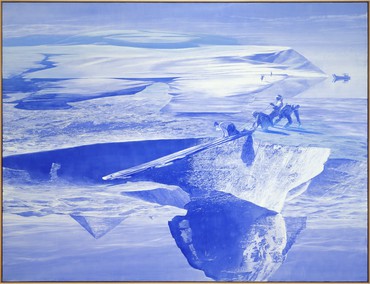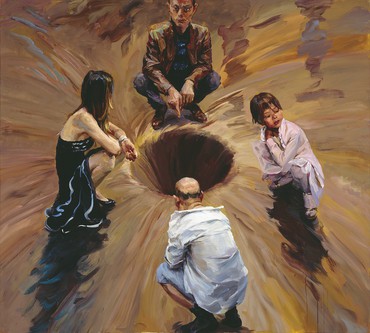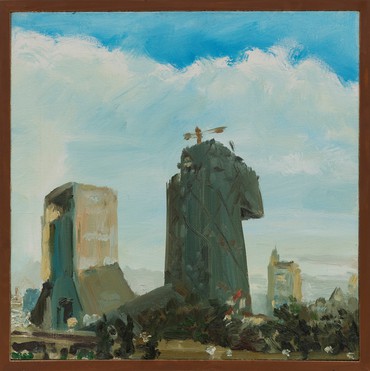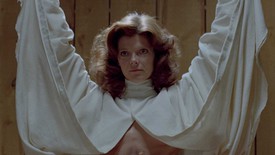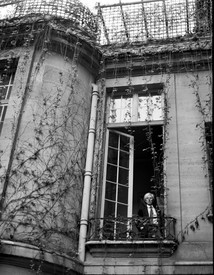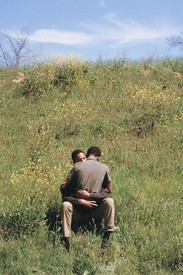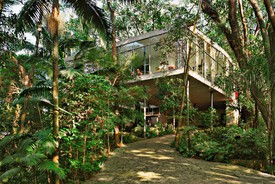In 1990, Vitaly Komar, a key figure of the Sots Art movement, introduced Mark Tansey to a community of Chinese painters who had recently arrived in New York from Beijing. In return, Tansey organized an informal exhibition of their paintings in his New York studio, entitled Transformations (1994).
Twenty-three years later, Figurative Diaspora, co-curated by Tansey and Peter Drake, Dean of the New York Academy of Art, presents paintings by five Chinese artists, three of whom participated in Tansey’s Transformations exhibition, alongside works from five Russian artists who had been creating “unofficial,” subversive, non-state sanctioned art decades earlier. In serendipitous coincidence, a scholarly publication Thank You for Your Love 1994, edited by Xin Wang, curator and art historian based in New York, with contributions from Cindy Xingyi Qi, MA student at the Institute of Fine Arts, New York University, will be available in the summer of 2018 to closely examine the multifaceted implications of the Transformations gathering not only for the participating artists, but also for the art historical discourses in 1990s New York and that of contemporary Chinese Art.
In addition to Drake, Komar, Tansey, and Wang, speakers also include Jane DeBevoise, Chair of the Board of Directors of Asia Art Archive in Hong Kong and New York, and Heidi Elbers, an artist and Director of Exhibitions and Alumni Affairs at the New York Academy of Art. This is a preview of the full conversation that will appear in the Summer 2018 Gagosien Quarterly, on newsstands May 1, 2018.
Peter DrakeFigurative Diaspora at the New York Academy of Art in some ways was motivated by the Transformations exhibition that was put together by Mark Tansey back in 1994. It was hosted in his apartment and consisted of four Chinese socialist realist artists including Liu Xiaodong, Chen Danqing, Yu Hong, and Ni Jun. In Figurative Diaspora is this notion that a visual language was migrating across cultures in the East while it was marginalized in America and Western Europe. It was still being preserved and to a degree, re-enlivened as propaganda. This language was kept alive.
Vitaly, you introduced these artists to Mark so maybe you can explain how you first encountered their work.
Vitaly KomarAt that time, Alexander Melamid and I published a call to artists in Artforum magazine. We asked for proposals of what to do with Soviet communist-era monuments or Socialist monuments to Vladimir Lenin and Joseph Stalin, because Russia started to destroy these monuments in the early 1990s after the collapse of the Soviet Union. Artists from countries including Germany, China, and Russia responded to this. Our studio became a kind of meeting place.
PDWhen you saw the Chinese artists, did you immediately recognize traces of the education that you received in Russia?
VKYes. Moscow represented a traditional Western academy for China in the same way that Rome did for Russian artists in the nineteenth century. Russian artists were moving to Rome to study the Renaissance and Baroque periods.
PDVitaly, were you and Mark friends at that point?
Mark TanseyYes, we had met. I very much admired Komar and Melamid’s work and how they had internalized critical content in the socialist realist form.
PDWere you ever in a studio of theirs at the time?
MTThe first time I visited their studio was the evening-meeting Vitaly mentioned earlier. That’s where I first saw slides of Chen Danqing’s pictures and was introduced to him.
PDIn your essay for the Transformations booklet, you said, “Chen’s work served as an introduction to me to the works of Liu Xiadong, Yu Hong, and Ni Jun. And this transformational edge in his work led me to appreciate the importance of understanding their work in terms of extending temporal transformations of their culture rather than the narrow temporal postures of mine.” You were seeing it through a very particular point of view and it took you awhile to adjust.
MTIt was common at that time to view contemporary art as existing in a singular, formal present. But apprehending the art of Chen Danqing or Komar and Melamid involved multiple times, multiple styles, and multiple relations between form and content.
Heidi ElbersPeter and Mark, you have been working towards the Figurative Diaspora exhibition for quite a while. Can you talk about your thought process?
PDIt first started with that old school idea of focusing on technical sophistication. But over the past ten or fifteen years, it’s changed dramatically and now the proposition is something more like traditional skills and contemporary discourse. It always felt like the artists that were in Transformations and Figurative Diaspora had made an enormous effort to acquire an incredibly difficult set of skills and they’re trying to do something that’s progressive with it that hasn’t been seen before. Part of what makes it so interesting is that the language has morphed as its moved along. The grammar has changed. Some of the tropes from Soviet socialist realism still show up. You’ll see figures portrayed from below or lit with artificial lights and things like that, but being used in such different ways now, and it feels like there’s a real connection between all three cultures.
Vitaly, when you were a young man did you ever make official art?
VKYes, I did it when I was very young. People compete for these commissions because the government pays very well. In Soviet Russia there were not many private collectors. You needed to make your living. Everything belonged to the government. In Soviet Russia, the government was your landlord, they owned land, supermarkets, and police.
PDThere was only one client.
MTVitaly, the meetings you hosted back in the ’80s and ’90s were really inspiring. In spite of the language barriers, different histories, and authority systems it was as if the pictorial language we had in common had taken on a life of its own.
VKAnd I look at all these relationships that we formed. It was a time of hope because everybody believed that something new was happening.
HEVitaly, could you talk a bit more about the history of Sots Art? You are one of the founders of the movement [Soviet Pop Art].
VKSots Art is akin to Pop Art in the Soviet Union. I can see similarities between totalitarian mass propaganda in Soviet Russia and the culture of advertising in the US. All forms of visual propaganda try to push people towards doing something. In the case of commercials, it’s igniting a desire to buy or consume. In the case of visual propaganda, they portray a positive image of the future or glorify the government. It’s a concept that attempts to manipulate consumers. Western commercials are the propaganda of consumerism. And Soviet visual propaganda are the commercials of socialism, ideology, or communist ideas. They have clear parallels, and that’s why Sots Art seems similar to Pop Art.
XIN WANGMark and Vitaly, I see irony as a prominent element in some of your works. Symbolism and irony are present in the work of some contemporary Chinese artists, particularly in those who practice the highly satirical Political Pop style, but what is striking about the four artists in Transformations is an earnest attitude, almost with no hint of irony.
VKFor me, Sots Art was a type of self-purification because I felt brainwashed in school. It was through self-irony and introspection that I felt purified. Self-irony is quite a strong weapon. I’m not sure how the Chinese understood this, but I see a lot of Sots Art in China now.
Jane DeBevoiseYes, it’s interesting that Sots Art predates Political Pop in China. Political Pop really started toward the end of the eighties and continued into the mid-nineties. But what you’re describing is more about how Chinese artists were recognizing similarities between consumer advertising and propaganda and relating it to the Chinese government propaganda they had been exposed to growing up. Chinese Political Pop emerged at the moment China was beginning to embrace Western capitalism and reject communist ideology or the most strident application of Chinese ideology. Artists were very sensitive to that and saw the trap that they were about to fall back into.
MTIt reminds me a little bit of a dilemma that art graduate students faced in the late ’70s in New York. The prevalent, “end-game art” practices were found to be at odds with the critique of the art commodity. For some, critical practice replaced art practice. There were those of us who found ways to internalize critique in the art and learned to live with the paradox.
JDBThat’s a great description. For me, there seem to be many parallels between Russia and China. I have always wanted this conversation to happen. When I see young Russian scholars coming out of universities, I try to push them towards Chinese studies. I think they’d bring such an interesting perspective that we as Westerners would not necessarily bring. For example, with Political Pop, there was always a question in my mind as to whether the Chinese had seen Sots Art before they did Political Pop or were they just identifying the same post-socialist condition that intrigued the Russian artists.
VKOnce, I saw a copy of Carter Ratcliff’s book about Sots Art and my work in Beijing. It was a Chinese translation of his book. So I asked if he knew it was translated and available in China? He said, “No, they never asked permission.” [laughter]
PDWe discussed some of the similarities between the two cultures, in relation to Sots Art and Political Pop, but what are some of the differences? There’s some palette differences obviously.
JDBOne thing Vitaly said that I think is interesting is that he saw Sots Art as a critique.
VKSelf-critique. For me it was self-criticism.
JDBIn China it seems that there’s still a reverence for Mao. That is one thing that’s different. Even at the height of Political Pop there was still a strong reverence for him as a founding father, as someone who sent the Westerners packing, who defeated the Japanese along with some help from other countries including the United States. He is somehow seen as bringing dignity back to China, despite all the terrible things that happened in the Cultural Revolution, the people who died, and the thirty million people who starved. Somehow that has been reconciled and the positive aspects of Mao continue in the imagination of the Chinese, even today. In Russia today, it seems the cratering of the socialist experiment or the utopian project continues to resonate and that decline is attached to political figures.
It was common at that time to view contemporary art as existing in a singular, formal present. But apprehending the art of Chen Danqing or Komar and Melamid involved multiple times, multiple styles, and multiple relations between form and content.
Mark Tansey
VKBut I still believe that the Russian experience of utopia is a very important tragic lesson for humanity. I don’t know if we really have the ability to learn from history, but it was a very important lesson in how the best intentions went awry. As the saying goes, “the road to hell is paved with good intentions.”
JDBYes, I think that’s a difference.
XWAnd I think Political Pop in general has less figuration and realism.
JDBIt’s more poster art. It’s not really socialist realism. It’s flat, more like graphic design. They’re picking up on the posters that they painted during their childhood and the prevalence of those flat colors. The whole idea of irony is an interesting question. Where is the irony?
VKIt’s related to the idea of self-reflection. Self-irony is only when the idea looks at yourself from another side, from another point of view.
HEMark, I want to ask about the artist as curator experience. You curated this show in the past, Transformations, and now you’re co-curating this show with Peter. Does the experience of curating make you see things differently in the studio? Have you thought about that?
MTCurator is probably the wrong word. What was your term back in the ’90s, Vitaly? Instigator? [laughter] I’m one who instigates, I want to see what’s going to happen. The pictures came to my attention and I was fascinated to see how the questions, the ideas continue.
PDThe only other time I remember you curating was at the MFA in Boston where you put together a show from their collection and that was fascinating. I love that tradition where an artist is having a solo show and is given free rein and then everything becomes a kind of marker for who you are. You’re mixing and matching from decorative arts, painting, sculpture.
MTYou’re having relationships. It’s a lovely experience.
JDBSo in Transformations, did the artists propose the selections of their own work? Did you talk about an idea that you wanted to develop or was it really just about them sharing the most interesting work they had been doing at that time?
MTThey chose their own work. In the previous three years since the Komar and Melamid meeting, I made numerous visits to Chen Danqing’s studio on 42nd Street. It was like walking into a space between worlds. It was beyond the dictates of any singular authority or ideology. The paintings displayed freedom and vitality in the crossing of different times, styles, and cultures. I saw this work acutely as self-authoring, as embodying “self-representation.”
I found in later meeting Liu Xiaodong, Yu Hong, and Ni Jun that where spoken language presented obstacles that the pictorial language we had in common was wonderful conversation and provided a sense of kindred spirits.
The Transformations show itself was in a “space between worlds”—that is neither a gallery nor an academic institution. It was an appointment exhibition in the spirit of Komar and Melamid’s studio meetings. And it was an extension from the pictorial conversations in Chen Danqing’s studio that were so vividly self-representing.
Figurative Diaspora is on view at the New York Academy of Art through March 4, 2018.
